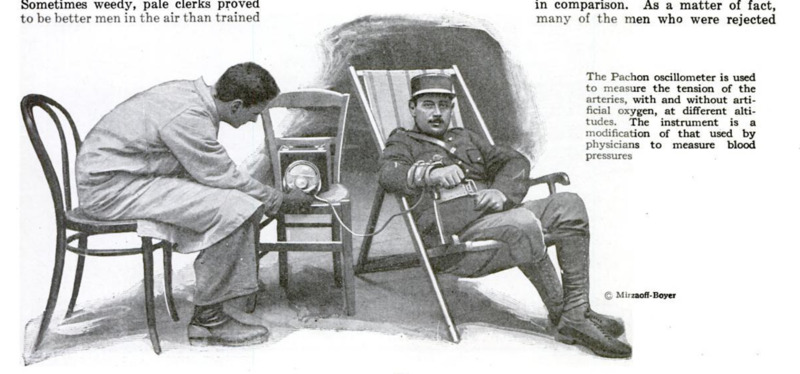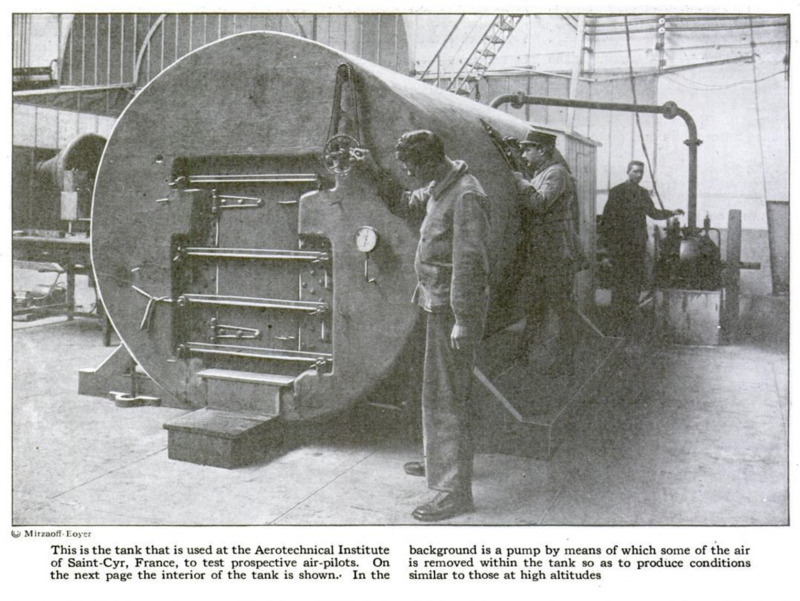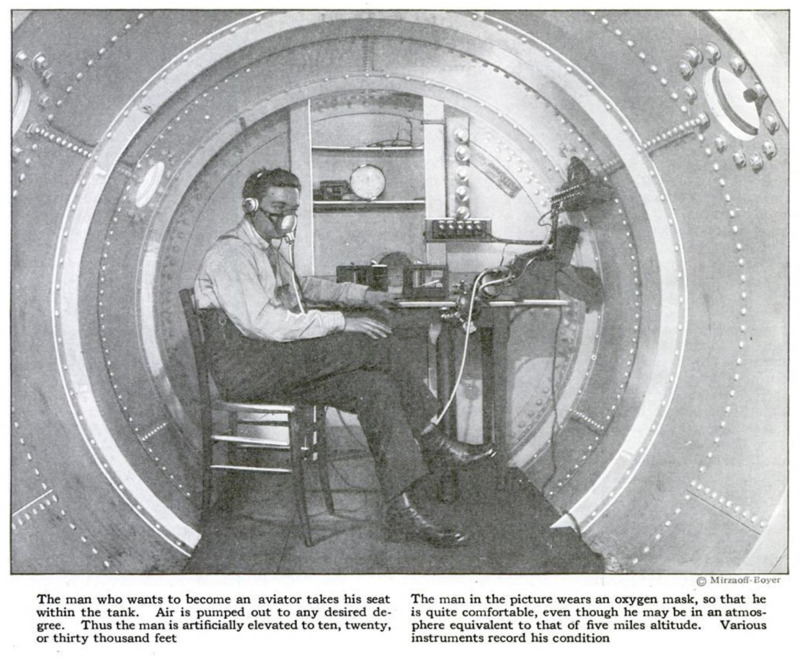-
Titolo
-
Testing prospective air-pilots
-
Article Title and/or Image Caption
-
Five Miles High in a Tank
-
Caption 1: This is the tank that is used at the Aerotechnical Institute of Saint-Cyr, France, to test prospective air-pilots. On the next page the interior of the tank is shown. In the background is a pump by means of which some of the air is removed within the tank so as to produce conditions similar to those at high altitudes
-
Caption 2: The man who want to become an aviator takes his seat within the tank. Air is pumped out to any desired degree. Thus the man is artificially elevated to ten, twenty, or thirty thousand feet. The man in the picture wears an oxygen mask, so that he's quite comfortable, even though he may be in an atmosphere equivalent to that of five miles altitude. Various instruments record hi condition
-
extracted text
-
A CROSS-EYED, one-legged man
of sixty may be a good sea-cap-
tain; but a twenty-five-year-old
dyspeptic will be a failure as an air-
pilot. Because a man has flown a
few times he is no more fitted to be an
air-pilot than a fourteen-year-old girl
who has taken a few piano lessons is
justified in competing with Hofmann.
Who is fit to guide a flying-machine
through the air? The Germans in the
early days of the war used to select
their flyers from the cavalry. English
athletes and polo-players proved to be
good airmen. Some of our best flyers
were once automobile and motorcycle
racers.
But the rigorous test of war proved
quickly enough that athletic prowess
and a good physique are not enough.
Sometimes weedy, pale clerks proved
to be better men in the air than trained
athletes who had learned to handle a
flying-machine.
As the war progressed it became
apparent that recruits for the flying
service must be scientifically selected.
The fate of an army depended on the
character of the men who fought at
great heights, photographed the enemy
positions, or watched the fall of shells.
Moreover, it was an expensive business
to train a flyer and then to find him
unfit.
It is said that it cost the American
government as much as $50,000 to fit
a man to fly; but the figure must surely
include the damage sustained by the
training airplane. At all events, it
was known long before we entered the
war that the British lost 95 per cent of
their airmen, not from bullets, but
from physical defects. A taint of
epilepsy, the slightest tendency to
vertigo, persistent headache, nervous-
ness, and easily induced fatigue were
sure to prove the undoing of a brave
man in the air.
So it came about that applicants for
the air service were systematically
studied, both psychologically and
physically, to discover latent disabili-
ties. - Men were whirled in chairs to
test their sense of equilibrium; their
eyes were examined; their family his-
tory was inquired into; their chest
expansion was measured; their height
and weight were noted. If all the
ideals set up could have been met by
any of the applicants, Apollo would
have seemed an imperfect weakling
in comparison. As a matter of fact,
many of the men who were rejected
by our own army entered the Cana-
dian Royal Flying Corps and gave a
good account of themselves.
Not so long ago the conscience of a
United States Army medical officer
troubled him because he discovered
that the best flyer in his camp had
flat feet!
Another flyer of unquestionable
ability had slightly defective vision in
one eye. Two medical examiners
have been known to scratch their
heads for half an hour because an ap-
plicant, acceptable in every other
respect, had a chest expansion one
quarter of an inch less than the
standard.
Now that we have entered the period
of commercial flying, it becomes more
than ever necessary to determine the
fitness of a man to pilot a flying
machine.
What is wanted is not that extraor-
dinary product, the ace, but a high
average type.
It is doubtful whether much reli-
ance can be placed on the whirling-
chair test. Psychological tests, how-
ever, are certainly important. It
takes a man from nineteen hundredths
to twenty hundredths of a second to
make up his mind to carry out an act
in an emergency his reaction time.
This reaction time may be delayed by
fatigue, drugs, and excesses. On the
other hand, it is found to be some-
what lower at times in men who are
physically fit than in others.
After a man loses his head there is
usually no time for correction in the
air, Hence the French may be right
in rejecting an applicant who is too
slow by even the infinitesimal part of
a second.
When a pilot loses his head, he
may move the throttle the wrong
way; he may keep his engine running
full speed when he should throttle
down; he may switch off the power
entirely when he needs all the speed
that he ean command.
Brain Fag Breeds Indifference
Fatigue —above all, brain fatigue —
may prove as fatal as a poor reaction
time.
When the brain is fagged out the
man has neither the power nor the
reason to decide and act. This is
probably due to the many impressions
received by the brain during flight.
He feels alone. He is not afraid. He
is simply appalled by the enormity of
the enterprise in which he is engaged.
Helpless, stupéfied, he awaits events
and takes little part in the control of
‘his machine.
It is altogether likely that fast pas-
senger-carrying airplanes of the future
will fly at altitudes far above those at
which the highest battles were fought
in the air. We are told that above an
altitude of thirty thousand feet and
more the winds are in the nature of
planetary swirls into which a machine
should be guided in order to gain an
advantage in speed and in economy of
power.
Now, the human organism was
evolved to live on the earth, not above
it. Asa man goes up, the total quan-
tity of air in a lungful decreases. He
must breathe faster. At nineteen
thousand feet he inhales only one half
the amount of oxygen and nitrogen
that he breathes at sea-level. At less
than twenty-five thousand feet the
lack of oxygen becomes distressing.
The human organism has the ability
of adapting itself to changed condi-
tions, but only within limits. How
far it can thus compensate itself de-
pends on the man. Before the flyer's
limit of compensation is reached, he
feels dizzy. Yet he is perfectly happy,
although he has lost his faculty of
judgment and has passed into a con-
dition of partial or total unconscious
ness. “I'm all right,” he says as he
flies along at fifteen or twenty thou-
sand feet. But the tests show that
every one of us is affected more or less
at such heights. It takes longer to
judge and to act; it is harder to read
an instrument. Positions of objects
are misjudged. Pain itself loses some
of its poignancy. Excessive fatigue,
nausea, and vertigo assert themselves.
For these reasons the oxygen tank
has become an indispensable part of
the high fiyer's equipment. All the
recent records of Rohlfs and Schroeder
were made with the assistance of
oxygen. It is not impossible that in
the high-flying passenger-carrying air-
plane of the future the crew and the
passengers will sit in hermetically
sealed compartments filled with oxygen
supplied from tanks. Otherwise pas-
sengers must wear oxygen masks.
Often a pilot crashes at the end of
a rapid descent. He has no recollec-
tion of what happened; he lost con-
sciousness .and was actually asleep.
This is highly significant; for this is a
state that is induced by an ample sup-
ply of oxygen or fresh air at full pres-
sure after a period of degradation. It
is a phenomenon often met with by
students of the low-oxygen problem.
Tt occurs in a wide variety of condi-
tions—in miners escaping damp, in
city firemen after coming out of smoke,
in the older type of submarines on
opening the hatches after submer-
gence, in persons who are given oxygen
after overexertion on a mountain and
after low-oxygen experiments in the
laboratory. But in none of these con-
ditions are the consequences so serious
as for the aviator.
The Value of the Oxygen Tank
Oxygen plays such an important
part in flying that one of the most
important tests of physical fitness
consists in discovering how a man
will behave when he is partially de-
prived of it. The man is not carried
up into the air to be tested, partly
because it is unnecessary to do so and
partly because the conditions there are
against scientific observation. He is
placed in a tank from which some of
the air is pumped. Thus it is possible
to climb, barometrically speaking, to
any desired height.
These tanks are now employed by
the medical officers of all armies. By
their means the truth about a great
many airplane accidents has been de-
duced.
The subjects vary in every conceiv-
able way. The man who has a “weak
heart'” is usually found at the bottom
of the list;" he can stand very little
oxygen reduction. At the other ex-
treme is the man whose powers of
compensation are so good that he can
“go up” in the tank to twenty-five
thousand feet and show but a slight
change in adaptability from the
normal.
In these airtight testing chambers,
or tanks, from six to ten men can be
tested at a time, if need be. Oxygen
can be inhaled from a tube, with the
result that, although the artificial
altitude may be thirty thousand feet,
the faculties are normal. The effect
of high altitude on the heart, breath-
ing, and nerves without oxygen can
be noted. All the effects of a fall are
obtained by allowing the air to enter
the tank rapidly. Thus the baro-
metric conditions that obtain during
an actual flight can be imitated.
-
Autore secondario
-
Walter Bannard (author)
-
Lingua
-
eng
-
Data di rilascio
-
1920-12
-
pagine
-
21-23
-
Diritti
-
Public Domain (Google digitized)
-
Archived by
-
Filippo Valle
-
Alberto Bordignon (Supervisor)






